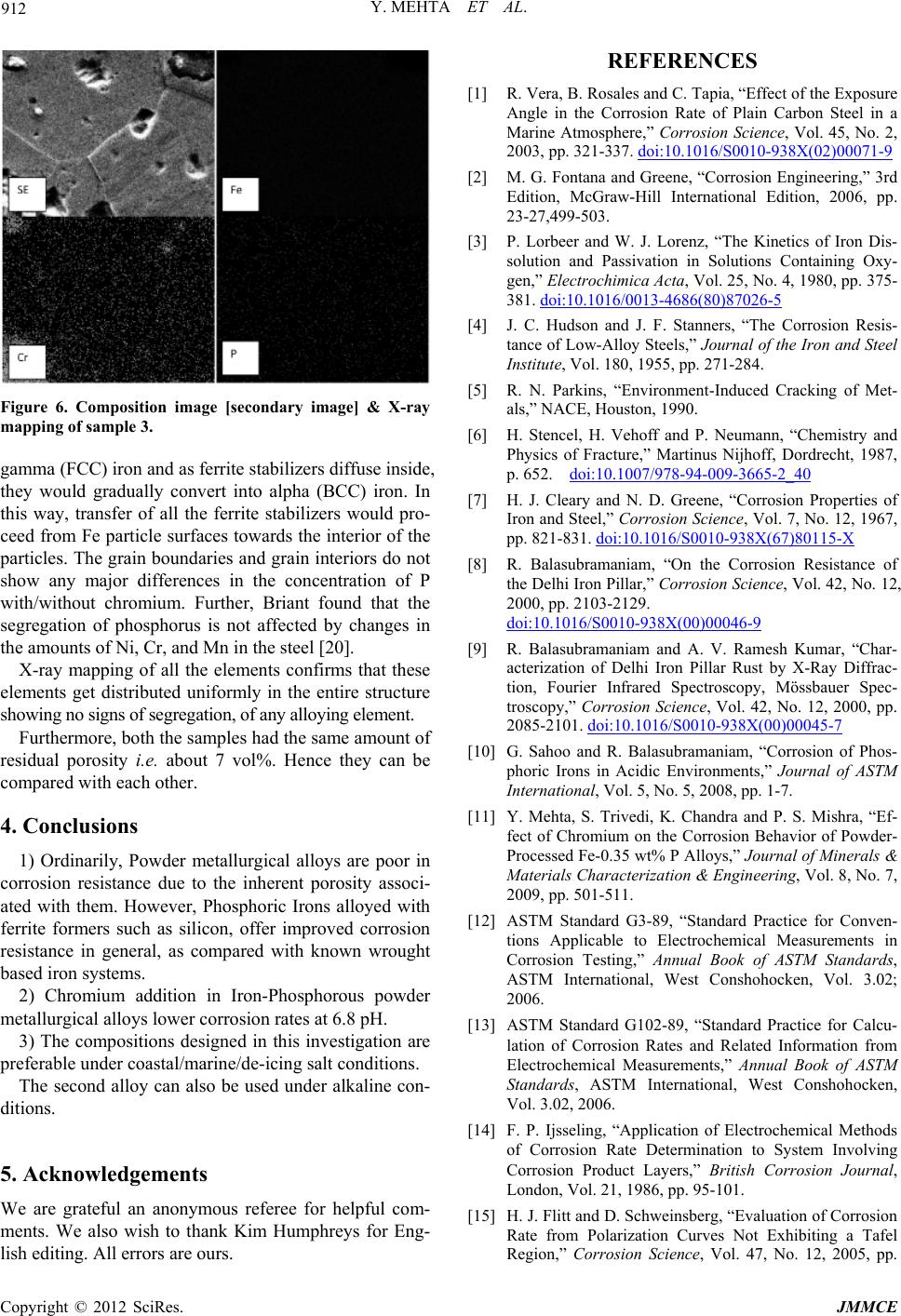
Y. MEHTA ET AL.
912
Figure 6. Composition image [secondary image] & X-ray
mapping of sample 3.
gamma (FCC) iron and as ferrite stabilizers diffuse inside,
they would gradually convert into alpha (BCC) iron. In
this way, transfer of all the ferrite stabilizers would pro-
ceed from Fe particle surfaces towards the interior of the
particles. The grain boundaries and grain interiors do not
show any major differences in the concentration of P
with/without chromium. Further, Briant found that the
segregation of phosphorus is not affected by changes in
the amounts of Ni, Cr, and Mn in the steel [20].
X-ray mapping of all the elements confirms that these
elements get distributed uniformly in the entire structure
showing no signs of segregation, of any alloying element.
Furthermore, both the samples had the same amount of
residual porosity i.e. about 7 vol%. Hence they can be
compared with each other.
4. Conclusions
1) Ordinarily, Powder metallurgical alloys are poor in
corrosion resistance due to the inherent porosity associ-
ated with them. However, Phosphoric Irons alloyed with
ferrite formers such as silicon, offer improved corrosion
resistance in general, as compared with known wrought
based iron systems.
2) Chromium addition in Iron-Phosphorous powder
metallurgical alloys lower corrosion rates at 6.8 pH.
3) The compositions designed in this investigation are
preferable under coastal/marine/de-icing salt conditions.
The second alloy can also be used under alkaline con-
ditions.
5. Acknowledgements
We are grateful an anonymous referee for helpful com-
ments. We also wish to thank Kim Humphreys for Eng-
lish editing. All errors are ours.
REFERENCES
[1] R. Vera, B. Rosales and C. Tapia, “Effect of the Exposure
Angle in the Corrosion Rate of Plain Carbon Steel in a
Marine Atmosphere,” Corrosion Science, Vol. 45, No. 2,
2003, pp. 321-337. doi:10.1016/S0010-938X(02)00071-9
[2] M. G. Fontana and Greene, “Corrosion Engineering,” 3rd
Edition, McGraw-Hill International Edition, 2006, pp.
23-27,499-503.
[3] P. Lorbeer and W. J. Lorenz, “The Kinetics of Iron Dis-
solution and Passivation in Solutions Containing Oxy-
gen,” Electrochimica Acta, Vol. 25, No. 4, 1980, pp. 375-
381. doi:10.1016/0013-4686(80)87026-5
[4] J. C. Hudson and J. F. Stanners, “The Corrosion Resis-
tance of Low-Alloy Steels,” Journal of the Iron and Steel
Institute, Vol. 180, 1955, pp. 271-284.
[5] R. N. Parkins, “Environment-Induced Cracking of Met-
als,” NACE, Houston, 1990.
[6] H. Stencel, H. Vehoff and P. Neumann, “Chemistry and
Physics of Fracture,” Martinus Nijhoff, Dordrecht, 1987,
p. 652. doi:10.1007/978-94-009-3665-2_40
[7] H. J. Cleary and N. D. Greene, “Corrosion Properties of
Iron and Steel,” Corrosion Science, Vol. 7, No. 12, 1967,
pp. 821-831. doi:10.1016/S0010-938X(67)80115-X
[8] R. Balasubramaniam, “On the Corrosion Resistance of
the Delhi Iron Pillar,” Corrosion Science, Vol. 42, No. 12,
2000, pp. 2103-2129.
doi:10.1016/S0010-938X(00)00046-9
[9] R. Balasubramaniam and A. V. Ramesh Kumar, “Char-
acterization of Delhi Iron Pillar Rust by X-Ray Diffrac-
tion, Fourier Infrared Spectroscopy, Mössbauer Spec-
troscopy,” Corrosion Science, Vol. 42, No. 12, 2000, pp.
2085-2101. doi:10.1016/S0010-938X(00)00045-7
[10] G. Sahoo and R. Balasubramaniam, “Corrosion of Phos-
phoric Irons in Acidic Environments,” Journal of ASTM
International, Vol. 5, No. 5, 2008, pp. 1-7.
[11] Y. Mehta, S. Trivedi, K. Chandra and P. S. Mishra, “Ef-
fect of Chromium on the Corrosion Behavior of Powder-
Processed Fe-0.35 wt% P Alloys,” Journal of Minerals &
Materials Characterization & Engineering, Vol. 8, No. 7,
2009, pp. 501-511.
[12] ASTM Standard G3-89, “Standard Practice for Conven-
tions Applicable to Electrochemical Measurements in
Corrosion Testing,” Annual Book of ASTM Standards,
ASTM International, West Conshohocken, Vol. 3.02;
2006.
[13] ASTM Standard G102-89, “Standard Practice for Calcu-
lation of Corrosion Rates and Related Information from
Electrochemical Measurements,” Annual Book of ASTM
Standards, ASTM International, West Conshohocken,
Vol. 3.02, 2006.
[14] F. P. Ijsseling, “Application of Electrochemical Methods
of Corrosion Rate Determination to System Involving
Corrosion Product Layers,” British Corrosion Journal,
London, Vol. 21, 1986, pp. 95-101.
[15] H. J. Flitt and D. Schweinsberg, “Evaluation of Corrosion
Rate from Polarization Curves Not Exhibiting a Tafel
Region,” Corrosion Science, Vol. 47, No. 12, 2005, pp.
Copyright © 2012 SciRes. JMMCE